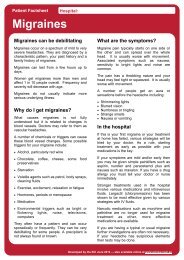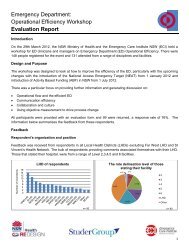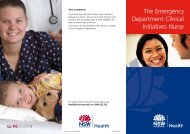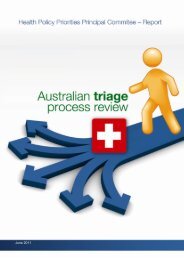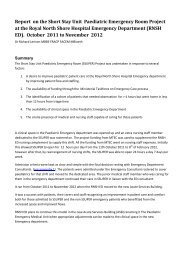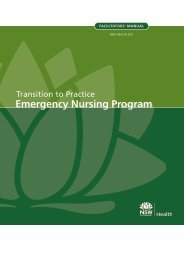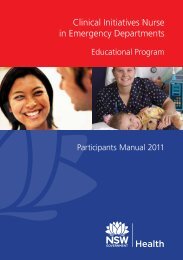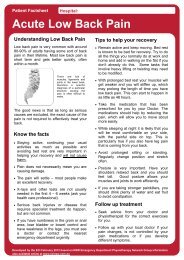Emergency Department Models of Care 2012 - NSW Health
Emergency Department Models of Care 2012 - NSW Health
Emergency Department Models of Care 2012 - NSW Health
- No tags were found...
Create successful ePaper yourself
Turn your PDF publications into a flip-book with our unique Google optimized e-Paper software.
SECTION 1The need for <strong>Emergency</strong> <strong>Care</strong> <strong>Models</strong>1.1 <strong>Emergency</strong> <strong>Care</strong> in Australia<strong>Emergency</strong> <strong>Department</strong>s (EDs) are under increasing pressuredue to the high demand for ED access to available inpatientbeds. This lack <strong>of</strong> available resources to meet emergencydemand is leading to crowding and access block resulting inprolonged patients waits for an inpatient bed.While efforts are being made to address this, includingimproving available bed stock and the development <strong>of</strong>hospital avoidance programs, EDs must continue to improvetheir operational efficiency. ED presentations across alltriage categories have increased in <strong>NSW</strong> EDs 1 , resulting inincreased admission workloads, ED crowding and delayedaccess to emergency care. The number <strong>of</strong> attendances hasincreased to the point that 11 <strong>NSW</strong> EDs in 2010/11 hadgreater than 50,000 presentations 2 .One way to meet the demand for emergency care is tooptimise ED and hospital bed capacity. The recent ‘National<strong>Health</strong> Reform Agreement on Improving Public HospitalServices’ includes a measure to improve this. The National<strong>Emergency</strong> Access Target (NEAT) aims to improve access toemergency care by reducing access block and its associatednegative outcomes. This target requires ED patients to beadmitted, referred for treatment in an inpatient unit, ordischarged within four hours.Only by engaging a whole-<strong>of</strong>-hospital can the obstacles toeffective patient flow be removed and the NEAT targetachieved 3 . For example, effective patient discharge andward transfer mechanisms can facilitate the timely transit <strong>of</strong>the emergency patient into a hospital bed, as can improvingthe time to inpatient acceptance for ED patients. However,in <strong>NSW</strong> hospitals, the target is currently not being achieved.Significant changes will need to occur in the acute hospitaland community care settings to do this.1 <strong>NSW</strong> <strong>Health</strong> Annual Report: Total ED Attendances by Year 2000-01 to 2008-09 &*DPE Predictions: 2009/10 to 2010/11.2 <strong>NSW</strong> Ministry <strong>of</strong> <strong>Health</strong>, <strong>Health</strong> Information Exchange extraction on 6th October2011.3 <strong>Department</strong> <strong>of</strong> <strong>Health</strong> and Ageing. National <strong>Health</strong> Reform. Expert Panel Review<strong>of</strong> Elective Surgery and <strong>Emergency</strong> Access Targets under the National PartnershipAgreement on Improving Public Hospital Services. Section 3: The Way Forward– <strong>Emergency</strong> <strong>Department</strong>s. (Accessed 04.04.12) http://www.yourhealth.gov.au/internet/yourhealth/publishing.nsf/Content/Expert-Panel-Report~Section-3ED overcrowding has been increasingly prevalent for over20 years 4 , 5 . Evidence from initiatives to addressovercrowding suggests a need to change current practicesthroughout the system to meet access targets, make betteruse <strong>of</strong> resources and maintain the quality <strong>of</strong> care delivery.The limitations <strong>of</strong> current ED and hospital processes include:■■■■■■■When ED front-end processes are not streamlined.These processes include: patient arrival and triage,registration, bed or clinical area placement, a review bya nurse and the medical assessment. The patient can<strong>of</strong>ten encounter lengthy periods <strong>of</strong> waiting betweeneach <strong>of</strong> these processes.When the patient is assessed by a senior medical <strong>of</strong>ficeronly after spending considerable time with juniormedical staff, or other clinical providers, leading todelays in decision-making and implementing treatment.When patients are placed into a bed on their arrival,regardless <strong>of</strong> whether their presentation necessitates abed. This can lead to subsequent bed block within EDrather than the efficient use <strong>of</strong> beds.When there are an increasing number <strong>of</strong>undifferentiated patients in the ED waiting room whoare at risk <strong>of</strong> deterioration.When there is a delay for review and acceptance <strong>of</strong>emergency admissions by the inpatient team, whichmay be due to many factors including competing workdemands, and lower prioritisation <strong>of</strong> new admissions.When there is a lack <strong>of</strong> available beds in the hospital,resulting in access block, crowding and no treatmentand/or bed spaces in the ED. As a result, ED patientsmay be managed outside the allocated clinical spaces <strong>of</strong>ED. Furthermore, ambulances may <strong>of</strong>f-load ED patientsinto unmonitored areas.When hospital back-end processes are not streamlined,resulting in delayed discharge, and the ‘least sick’patients occupying designated inpatient beds whilenew, emergency-admitted patients queue in the EDawaiting an inpatient bed.4 Wilner J, Gentle C, Halfpenny J, Heins A, Mehrotra A, Mikhail M, & Fite D,Optimizing <strong>Emergency</strong> Front-End Operations, Annals <strong>of</strong> <strong>Emergency</strong> Medicine, 2010,vol. 55, no.2, pp142-1605 Forero, R., Hillman, K. M., McCarthy, S., Fatovich, D. M., Joseph, A. P. andRichardson, D. B. (2010), Access block and ED overcrowding. <strong>Emergency</strong> MedicineAustralasia, 22: pp. 119–135. doi: 10.1111/j.1742-6723.2010.01270.xPAGE 4 <strong>NSW</strong> HEALTH <strong>Models</strong> <strong>of</strong> <strong>Emergency</strong> <strong>Care</strong>




